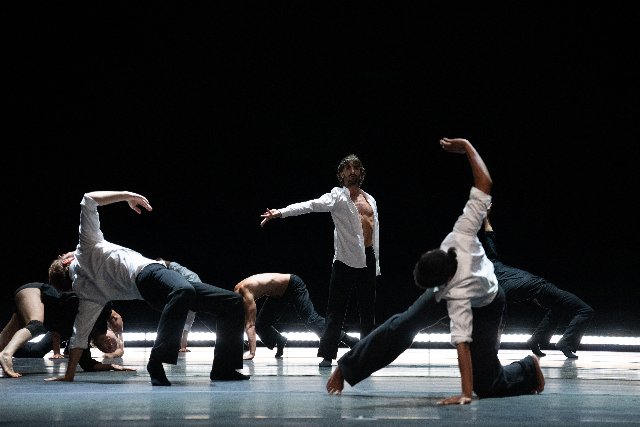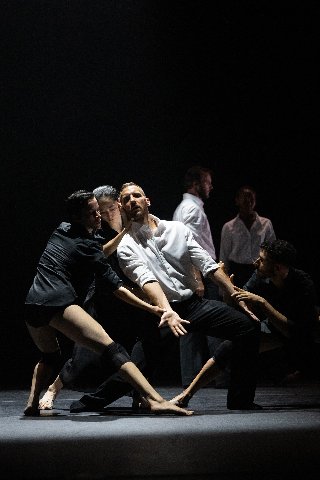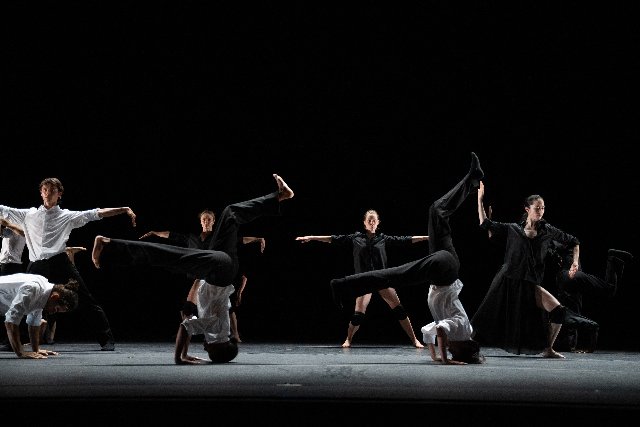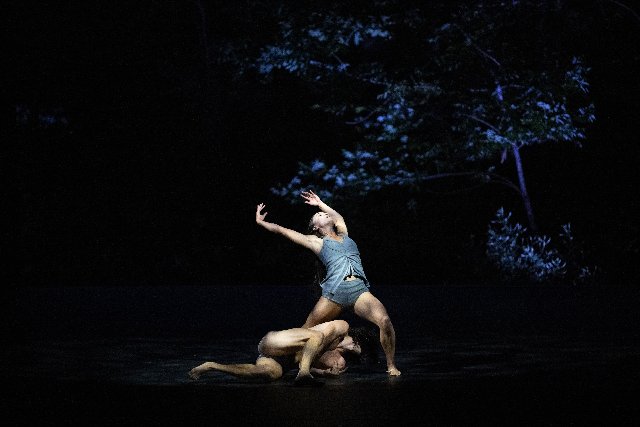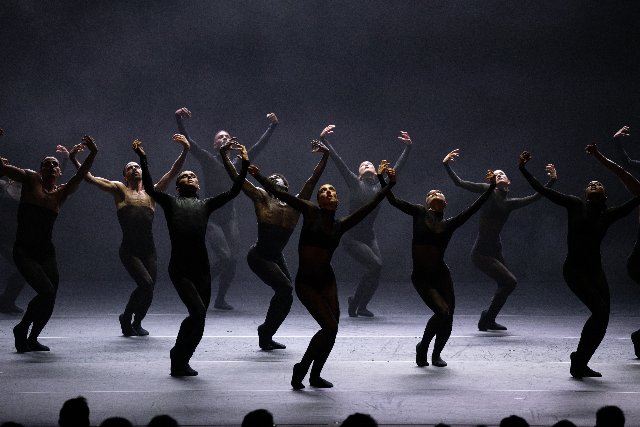Grand Théâtre de Genève at Jacob's Pillow
Improvising Plan B
By: Charles Giuliano - Jul 15, 2024
Ballet du Grand Théâtre de Genève
Ted Shawn Stage
Jacob’s Pillow
July 10 to 14, 2024
Director: Sidi Larbi Cherkaoui
General Manager: Ariel Cohn
Noetic (Excerpt)
Choreography, Sidi Larbi Cherkaoui
Costumes, Les Hommes
Lighting, David Stockholm
Music, The Gothenberg Orchestra led by chef Henrik Schaefer
Singer, Anna Vieira Leite
Musician, Shago Yoshii
Dramaturgy, Adolphe Binder
Faun
Choreography, Sidi Larbi Cherkaoui
Scenography and lighting, Adam Carree
Music, Claude Debussy and Nitin Sawheny, Simon Rattle and Berlin Philharmoniker
Costumes, Hussein Chalayan
Dancers, Madeline Wong and Oscar Comesana Salgueiro
Strong
Choreography, Sharon Eyal
Co-Choreography, Clyde E. Aceher
Scenic, Sharon Eyal and Gai Behar
Music, Ori Lichtik
Lighting, Alan Cohen
Costumes, Rebecca Hytting
Grand Théâtre de Genève arrived for the scheduled third week of the Jacob’s Pillow season. Sets for Noetic, which was to have its North American premiere, however, did not.
The company was to present Faun and Noetic each for one of two acts.
In emergency mode, with just two days of rehearsal, artistic director, Sidi Larbi Cherkaoui, was forced into plan B. Deleting scenes that required the missing sets he devised an “Excerpt” of the complex ballet. In reduced form it was coupled with Faun.
After an intermission the company performed Strong a complex work some 45 minutes in duration by Sharon Eyal. That was most fortuitous as it brought another signifying dance to identify the strength and unique direction of a spectacular company.
At the edge of the stage Shago Yoshii used sticks to beat several drums with differing tonal ranges. He also played flute. After the curtain call for Noetic he returned for an interval or musical knee play performing on a bowed, string instrument suspended by one hand. His contribution was much appreciated.
The curtain parted to reveal a cluster of dancers as frozen sculpture within a square of light. At the end of the piece they would return full circle to that exact pose, lighting and mood.
The premise of this complex work is that the whole is greater than the sum of its parts. There are organic changes and reconfigurations. Often that breaks down to clusters of dancers executing the same moves. The eye does not know quite how to settle. Where to focus, when several groups of dancers are performing identical movements?
Lines are formed that morph into ever changing configurations. Dancers flow in and through each other. There is the sense of fluidity and movement.
At one point a woman walks on a diagonal through the dancers and then exits. For a moment we followed her trajectory which seemed to be of significance, or perhaps not so.
In a black dress and low heels Ana Vieira Leite sang beautifully. The lyrics in an unfamiliar language, however, shed no light on the context of this dance. Similarly, one of the dancers delivered the equivalent of the garbled Lucky speech from Waiting for Godot. The screed regarded technology and social change but was a mish-mash at least to my ears.
At times the choreography depicted the sense of arcane technology. Perhaps Cherkaoui is evoking an avant-garde update of Charlie Chaplin gobbled up by a giant machine in Modern Times.
Program notes state that “Sacred geometry, city life as mechanical functions, the microcosm reflected in the macrocosm, all these structures leading to interconnectedness: Noetic touches on all of these themes in a poetic way. Deep inside, the knowledge, actions and consciousness are already there.”
L'après-midi d'un faune is a poem by the French author Stéphane Mallarmé. It describes the sensual experiences of a faun who has just woken up from his afternoon sleep and discusses his encounters with several nymphs during the morning in a dreamlike monologue.
In 1912 Vaslav Nijinski choreographed and danced the faun in a scandalous production for Serge Diaghilev’s Ballet Russe de Monte Carlo. He presented the faun in the frieze- like manner of a painting on a Grecian urn. Devoid of human morality the intent of the dance was essentially rape. In Greek mythology the faun is a signifier of lust. The maiden escaped but left behind a scarf. Nijinsky spread it out on stage and simulated copulation with it.
Here Cherkaoui has reinvented Faun as a love story. Madeline Wong and Oscar Comesana Salgueiro are equally passionate creating a stunningly sensual dance. The choreographer has ditched the signifying scarf.
While Nijinsky’s dance was created as stylized, Greek evoking relief the current dance is fully fleshed out and compellingly three-dimensional.
There are risks involved in messing with a masterpiece. Here Cherkaoui has proceeded boldly with expansion of the iconic score of Claude Debussy. The dance begins with that haunting, primeval flute refrain which is then further reprieved and embellished. It has been orchestrated by Nitin Sawheny and performed by Simon Rattle and Berlin Philharmoniker. The music of Debussy prevails but we are hardly aware when it is enhanced and expanded. It’s quite an accomplishment to take on and upgrade Debussy.
As with last week’s Royal Ballet the barn doors were opened to a view of unmanicured nature. If this trend continues Pillow might invest in some landscaping behind the shed.
Because of the flood of natural daylight the dancers were cast in shadow. We experienced their movement in silhouette. That might have easily been corrected.
With the Royal Ballet we enjoyed several versions of pas de deux. Here was yet another but completely contemporary with no reference to classical forms. Perhaps that’s a tribute to the radical modernism of Nijinsky.
It is fair to say that Cherkaoui has added a new Faun to the canon.
When we noted that Israeli choreographer, Sharon Eyal, and her Strong were added to the program I thought of Bette Davis in All About Eve. Indeed it was time to "fasten your seatbelts; it's going to be a bumpy ride."
Sharon Eyal, born in Jerusalem, danced with the Batsheva Dance Company from 1990 to 2008. With Batsheva, she worked for 23 years under Ohad Naharin, and adopted his “Gaga” technique as the base for her company L-E-V (love in Hebrew). We experienced Bathsheva and “Gaga” several years ago at Pillow and are still in recovery.
Not surprisingly Strong was a total assault and endurance test for the audience. Typically the dance is relentless.
To thumping techno music with gut wrenching hypnotic bass the curtain opened to see a cluster of dancers in moody smoke and barely visible.
They appeared to march/ prance in step in a restrained, disciplined, militaristic manner. The corps is an ersatz army with some unproclaimed mandate. Now and then there were precise shifts. In addition to marching in place there was use of the upper body with flailing arms. Heads would snap and shift in unison. Some passages evoked robotics. There was the sense of weaponizing individual body parts and functions.
With very little modulation of music and movement there was a relentless sensibility. There was a cult-like sense of intimidation and indoctrination.
For each of us individually there was arguably a moment when he “got it” whatever that was and craved to move on. Eyal reached that pressure point and bore down relentlessly. Time wore on to a breaking point. The point of this dance appeared to be our surrender or capitulation to her vision.
Which is to say that, having endured the experience, I can testify to survivor’s guilt. In the mode of Stockholm Syndrome let me say that Strong was fresh, original, titubating, trance inducing and galvanic. When you see this work just be sure that you’re properly buckled up.

